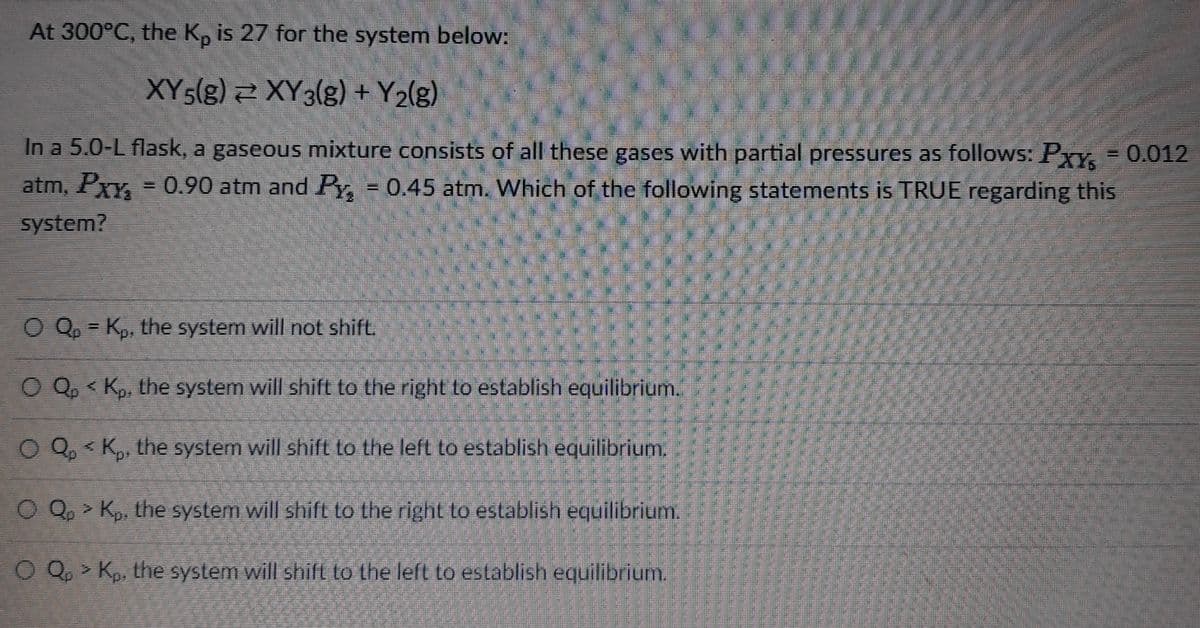At 300°C, the Kp is 27 for the system below: XY5(g) XY3(g) + Y₂(g) In a 5.0-L flask, a gaseous mixture consists of all these gases with partial pressures as follows: PxYs = 0.012 atm, Pxy₂ = 0.90 atm and Py₂ = 0.45 atm. Which of the following statements is TRUE regarding this system? O Qp = Kp, the system will not shift. O QpKp. the system will shift to the right to establish equilibrium. O QpKp, the system will shift to the left to establish equilibrium. O Qp> Kp. the system will shift to the right to establish equilibrium. O Qp> Kp, the system will shift to the left to establish equilibrium.
At 300°C, the Kp is 27 for the system below: XY5(g) XY3(g) + Y₂(g) In a 5.0-L flask, a gaseous mixture consists of all these gases with partial pressures as follows: PxYs = 0.012 atm, Pxy₂ = 0.90 atm and Py₂ = 0.45 atm. Which of the following statements is TRUE regarding this system? O Qp = Kp, the system will not shift. O QpKp. the system will shift to the right to establish equilibrium. O QpKp, the system will shift to the left to establish equilibrium. O Qp> Kp. the system will shift to the right to establish equilibrium. O Qp> Kp, the system will shift to the left to establish equilibrium.
Physical Chemistry
2nd Edition
ISBN:9781133958437
Author:Ball, David W. (david Warren), BAER, Tomas
Publisher:Ball, David W. (david Warren), BAER, Tomas
Chapter1: Gases And The Zeroth Law Of Thermodynamics
Section: Chapter Questions
Problem 1.21E: Pressures of gases in mixtures are referred to as partial pressures and are additive. 1.00 L of He...
Related questions
Question

Transcribed Image Text:At 300°C, the Ko is 27 for the system below:
1
XY5(g) = XY3(g) + Y₂(g)
In a 5.0-L flask, a gaseous mixture consists of all these gases with partial pressures as follows: PxYS = 0.012
atm, Pxy₂ = 0.90 atm and Py₂ = 0.45 atm. Which of the following statements is TRUE regarding this
system?
O Qp = Kp, the system will not shift.
O QpKp, the system will shift to the right to establish equilibrium.
O QpKp, the system will shift to the left to establish equilibrium.
O Qp> Kp, the system will shift to the right to establish equilibrium.
O Q> Kp, the system will shift to the left to establish equilibrium.
P
Expert Solution
This question has been solved!
Explore an expertly crafted, step-by-step solution for a thorough understanding of key concepts.
Step by step
Solved in 3 steps with 1 images

Knowledge Booster
Learn more about
Need a deep-dive on the concept behind this application? Look no further. Learn more about this topic, chemistry and related others by exploring similar questions and additional content below.Recommended textbooks for you

Physical Chemistry
Chemistry
ISBN:
9781133958437
Author:
Ball, David W. (david Warren), BAER, Tomas
Publisher:
Wadsworth Cengage Learning,

Chemistry: An Atoms First Approach
Chemistry
ISBN:
9781305079243
Author:
Steven S. Zumdahl, Susan A. Zumdahl
Publisher:
Cengage Learning

Chemistry
Chemistry
ISBN:
9781305957404
Author:
Steven S. Zumdahl, Susan A. Zumdahl, Donald J. DeCoste
Publisher:
Cengage Learning

Physical Chemistry
Chemistry
ISBN:
9781133958437
Author:
Ball, David W. (david Warren), BAER, Tomas
Publisher:
Wadsworth Cengage Learning,

Chemistry: An Atoms First Approach
Chemistry
ISBN:
9781305079243
Author:
Steven S. Zumdahl, Susan A. Zumdahl
Publisher:
Cengage Learning

Chemistry
Chemistry
ISBN:
9781305957404
Author:
Steven S. Zumdahl, Susan A. Zumdahl, Donald J. DeCoste
Publisher:
Cengage Learning


Chemistry for Engineering Students
Chemistry
ISBN:
9781337398909
Author:
Lawrence S. Brown, Tom Holme
Publisher:
Cengage Learning

Introduction to General, Organic and Biochemistry
Chemistry
ISBN:
9781285869759
Author:
Frederick A. Bettelheim, William H. Brown, Mary K. Campbell, Shawn O. Farrell, Omar Torres
Publisher:
Cengage Learning